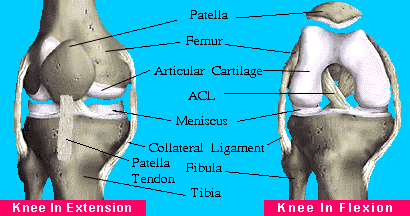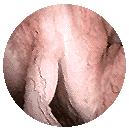

Torn Anterior Cruciate Ligament
Athletes Must Mentally
Recover
By Crystal Daily
North Carolina
Agricultural and Technical State
University


Athletes Must Mentally
Recover
By Crystal Daily
North Carolina
Agricultural and Technical State
University
Your surroundings slowly come into focus after you wake from the best nap you've ever experienced. The nurse comes to your aid and asks, "Would you like some ice chips?" You nod your head "yes" because nothing sounds better than ice chips; you're dehydrated. Next, you try to move your legs. The right feels fine but the left aches and it seems to be restricted in some type of a brace. You finally remember where you are.
You're in the recovery room after undergoing two hours of surgery on your left knee.
In August of 2001, I injured my left knee while playing volleyball as a player on the North Carolina Agricultural and Technical State University varsity women's volleyball squad . I was blocking in a game with Utah when I stepped on my teammates foot. My left knee buckled inward and I crumbled to the floor in severe pain. I had hyper extended my knee and in the process, chipped the underside of my kneecap. After sitting out for over a week, I was cleared by the school physician and immediately began to play in matches.
The most important factor in recovering from an injury in athletics is confidence. Without confidence, an athlete may feel they will never be able to return to their original state of performance.
After an injury, athletes may suffer from a state of emotional shock including bitterness, frustration, anger, and guilt. Athletes may also experience an identity crisis; athletes may feel that their injury is taking a part of their "self" image. These thoughts may increase if the player feels secluded or abandoned by their teammates and coach as a direct result to their injury.
After playing in over 30 matches, approximately 100 games in three months, my knee needed attention. The time finally came for me to return home for the holidays. My Christmas gift was to undergo arthroscopic surgery with a lateral release on December 19, 2001. After fainting from the sight of the I.V. inserted into my right hand, I don't remember much.
The number of injuries that occur at the secondary and intercollegiate levels of athletes has been estimated at close to 750,000 per year. Volleyball is just one of the numerous sports that suffer from multiple injuries. If an athlete chooses to have surgery, the aftermath is something that could never be expected.
Once my surgery was over, I spent a short amount of time in the recovery room prior to returning home. Home felt like a cage for the next week; I could not leave my house because my medication did not permit me to drive and also made me extremely nauseous. I thought the worst was over but I was fooling myself.
Therapy excited me in the beginning. The pain of stretching was incomparable and that wasn't the worst part. People staring at me in the grocery store or at the mall made me feel like an outcast. I also didn't know how to react to my friends and family sympathizing with me, asking me if I was okay all of the time, and worst of all, trying to do things for me. I felt helpless and began to feel worse about going through with my surgery.
Helplessness is a common characteristic that athletes develop after having surgery. The physical side to recover can be a slow process but athletes seem to suffer more from the psychological side of rehabilitation. This theory holds true for another varsity athlete at N.C. A&T SU named Camille Akins.
As the starting guard for the varsity Lady Aggie Basketball team, Akins injured her knee during a preseason practice while performing a jump stop. In November 2001, Akins had arthroscopic surgery and began rehabilitation immediately in order to be cleared to return to participate in the 2001-2002 season.
"It has been more of a mental game of recovery," said Akins at a recent interview. She explained her process in more detail and has found that "when I first returned, I was frustrated because I was telling my body to perform one way and my knee wouldn't react as fast as I wanted it to." Akins is looking forward to the off season to fully strengthen her leg for next year's season.
Once the athlete has recovered from their injury or has completed their rehabilitation program after surgery, the athlete may express fear and anxiety. This occurs because the athlete may worry about the possibility of re-injury as well as the anxiety felt about returning to practices or competition.
At this point in time, I have begun to participate in practices with limited movement. Due to my injury, I do not feel as a part of the team. I continuously collect loose volleyballs around the gym, keep score, or serve. When I serve to my teammates, I seem to expect to miss. My confidence level is at an all time low.
Terry Jones, a freshman inside blocker for the varsity Aggie football team is another victim that experienced a knee injury. While practicing in November during the 2001-2002 season, Jones tore his Anterior Cruciate Ligament (ACL) when a teammate tackled him from the right side. On December 11, Jones went under the knife to have his ACL repaired.
Jones has been rehabilitating his knee at least three times per week since his surgery. "It's been mentally exhausting and frustrating," Jones said, "I miss competition. I really wish that I could have played spring football because I know that I would have contributed to the team if my knee was healed." Jones hopes to return with his knee fully recovered in time for summer football practice to start.
As I attend physical therapy three times per week, I continue to struggle with the physical and mental aspects of recovery. Most of the time, it seems that recovery is more mentally challenging than physically. Attending physical therapy has also opened my eyes to the many people who are in my shoes, not all are volleyball players but arthroscopic surgery is not an uncommon procedure today.
More about Sports Medicine related to knee injuries
What is arthoscopic surgery?
Knee braces to improve movement and comfort
Copyright ©2002
Crystal Daily
All Rights Reserved
Citation Permitted Only With Credit